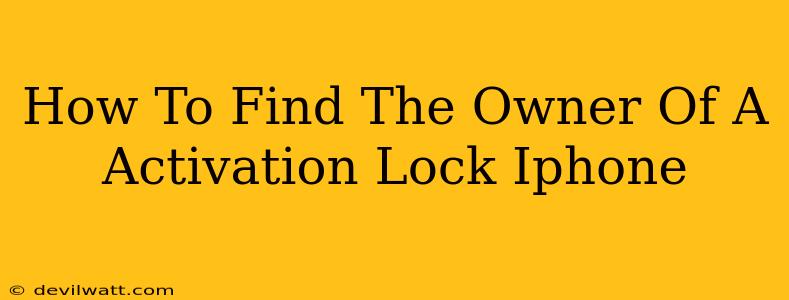Finding the original owner of an activation-locked iPhone can be tricky, as Apple's security features are designed to protect user privacy. There's no official method provided by Apple to bypass this security or directly identify the previous owner. However, there are some investigative steps you can take, though success isn't guaranteed. This guide explores these options and outlines what to expect.
Understanding Activation Lock
Before we delve into finding the owner, let's clarify what Activation Lock is. It's a crucial security feature integrated with Apple's Find My iPhone service. When enabled, it prevents anyone from using an iPhone even after a factory reset unless the original Apple ID and password are entered. This is a powerful deterrent against theft and unauthorized use. This means simply trying to reset the phone won't reveal the owner's identity.
Methods to Potentially Identify the Previous Owner (With Limited Success)
It's important to manage expectations. The chances of successfully finding the original owner are slim, particularly if the phone was legitimately sold or transferred. Here are some approaches, but remember, they are not foolproof:
1. Check the Phone's Physical Clues
This is your first and arguably most effective line of inquiry. Carefully examine the phone for any clues:
- Name or initials: Look on the case or screen protector. Someone might have personalized it.
- Stickers or labels: Delivery labels or other stickers sometimes remain on the device.
- Photos or data (if accessible): If you can access any photos or data (highly unlikely due to Activation Lock), carefully review them for identifying information.
- Purchase receipts: If the phone is sold second-hand and the original packaging is present, there might be purchase details.
2. Contact the Seller (If Applicable)
If you purchased the iPhone from a third-party seller (online marketplace, pawn shop, etc.), contacting them is crucial. They are legally obligated to provide information and evidence of ownership. Keep records of all communication and ensure you have a clear understanding of the transaction terms. If the device is stolen, report it to the relevant authorities immediately.
3. Investigate IMEI/Serial Number (Limited Potential)
The IMEI (International Mobile Equipment Identity) and serial numbers are unique identifiers for the phone. While these numbers themselves don't directly reveal the owner, you can use them to report the device as stolen (if applicable) to law enforcement. This could potentially lead to the identification of the owner through investigations. However, there is no public database linking IMEI/Serial numbers to owners.
4. Legal Avenues (If Necessary)
If you have legitimate reasons to locate the owner and other methods fail, you may need to pursue legal action. This is typically only recommended if the phone was acquired through fraudulent means. You'll need to consult with a legal professional to determine the best course of action.
Preventing Future Activation Lock Issues
The best way to avoid this situation is to take precautions when purchasing used iPhones:
- Verify the seller's legitimacy: Only buy from reputable sources.
- Ask for proof of ownership: Request receipts, original packaging, and other documentation.
- Ensure Activation Lock is removed: Before completing the purchase, verify that Activation Lock has been deactivated.
Disclaimer: This information is for guidance only and does not guarantee success in locating the owner of an activation-locked iPhone. Always prioritize ethical and legal methods. Contacting law enforcement is advised if you suspect the phone is stolen.

